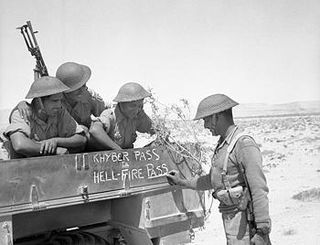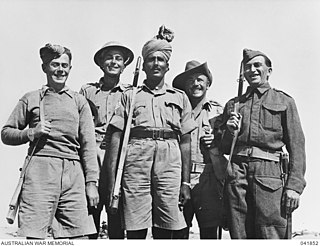
Fort Capuzzo was a fort in the colony of Italian Libya, near the Libya–Egypt border, next to the Italian Frontier Wire. The Litoranea Balbo ran south from Bardia to Fort Capuzzo, 8 mi (13 km) inland, west of Sollum, then east across the Egyptian frontier to the port over the coastal escarpment. The fort was built during the Italian colonial repression of Senussi resistance in the Second Italo-Senussi War (1923–1931), as part of a barrier on the Libya–Egypt and Libya–Sudan borders.

Operation Compass was the first large British military operation of the Western Desert Campaign (1940–1943) during the Second World War. British Empire and Commonwealth forces attacked Italian forces of the 10th Army in western Egypt and Cyrenaica, the eastern province of Libya, from December 1940 to February 1941.

The Commandos, also known as the British Commandos, were formed during the Second World War in June 1940, following a request from Winston Churchill, for special forces that could carry out raids against German-occupied Europe. Initially drawn from within the British Army from soldiers who volunteered for the Special Service Brigade, the Commandos' ranks would eventually be filled by members of all branches of the British Armed Forces and a number of foreign volunteers from German-occupied countries. By the end of the war 25,000 men had passed through the Commando course at Achnacarry. This total includes not only the British volunteers, but volunteers from Greece, France, Belgium, Netherlands, Canada, Norway, Poland, and the United States Army Rangers and US Marine Corps Raiders, Portuguese Fuzileiros Portuguese Marine Corps were modelled on the Commandos.
Layforce was an ad hoc military formation of the British Army consisting of a number of commando units during the Second World War. Formed in February 1941 under the command of Colonel Robert Laycock, after whom the force was named, it consisted of approximately 2,000 men and served in the Middle Eastern theatre of operations. Initially tasked with conducting raiding operations to disrupt Axis lines of communication in the Mediterranean it was planned that they would take part in operations to capture the Greek island of Rhodes.

Operation Sonnenblume was the name given to the dispatch of German and Italian troops to North Africa in February 1941, during the Second World War. The Italian 10th Army had been destroyed by the British, Commonwealth, Empire and Allied Western Desert Force attacks during Operation Compass (9 December 1940 – 9 February 1941). The first units of the new Deutsches Afrikakorps (DAK), commanded by Generalleutnant Erwin Rommel, departed Naples for Africa and arrived on 11 February 1941. On 14 February, advanced units of the 5th Light Afrika Division, Aufklärungsbataillon 3 and Panzerjägerabteilung 39 arrived at the Libyan port of Tripoli and were sent immediately to the front line east of Sirte.

Operation Battleaxe was a British Army offensive during the Second World War to raise the Siege of Tobruk and re-capture eastern Cyrenaica from German and Italian forces. It was the first time during the war that a significant German force fought on the defensive. The British lost over half of their tanks on the first day and only one of three attacks succeeded.

Operation Crusader was a military operation of the Western Desert Campaign during the Second World War by the British Eighth Army against the Axis forces in North Africa commanded by Generalleutnant (Lieutenant-General) Erwin Rommel. The operation was intended to bypass Axis defences on the Egyptian–Libyan frontier, defeat the Axis armoured forces near Tobruk, raise the Siege of Tobruk and re-occupy Cyrenaica.

The siege of Tobruk took place between 10 April and 27 November 1941, when elements of the Allied Army were trapped and besieged in the North African port of Tobruk by German and Italian forces. The defenders quickly became known as the Rats of Tobruk.

The Western Desert campaign took place in the deserts of Egypt and Libya and was the main theatre in the North African campaign of the Second World War. Military operations began in June 1940 with the Italian declaration of war and the Italian invasion of Egypt from Libya in September. Operation Compass, a five-day raid by the British in December 1940, was so successful that it led to the destruction of the Italian 10th Army over the following two months. Benito Mussolini sought help from Adolf Hitler, who sent a small German force to Tripoli under Directive 22. The Afrika Korps was formally under Italian command, as Italy was the main Axis power in the Mediterranean and North Africa.

Operation Brevity was a limited offensive conducted in mid-May 1941, during the Western Desert Campaign of the Second World War. Conceived by the commander-in-chief of the British Middle East Command, General Archibald Wavell, Brevity was intended to be a rapid blow against weak Axis front-line forces in the Sollum–Capuzzo–Bardia area of the border between Egypt and Libya. Although the operation got off to a promising start, throwing the Axis high command into confusion, most of its early gains were lost to local counter-attacks, and with German reinforcements being rushed to the front the operation was called off after one day.

The Frontier Wire was a 271 km (168 mi) obstacle in Italian Libya, along the length of the border of British-held Egypt, running from El Ramleh, in the Gulf of Sollum south to Jaghbub parallel to the 25th meridian east, the Libya–Egypt and Libya–Sudan borders. The frontier wire and its line of covering forts was built by the Italians during the Second Italo-Senussi War (1923–1931), as a defensive system to contain the Senussi population, who crossed from Egypt during their resistance against Italian colonisers.

Operation Skorpion from 26 to 27 May 1941, was a military operation during the Western Desert Campaign of the Second World War. The operation was conducted by Axis forces under the command of Colonel Maximilian von Herff and British forces under Lieutenant-General William "Strafer" Gott. A counter-attack was made on British positions at Halfaya Pass in north-western Egypt, which had been captured during Operation Brevity (15–16 May).Unternehmen Skorpion was the second offensive operation commanded by Rommel in Africa.

The Italian invasion of Egypt was an offensive in the Second World War, against British, Commonwealth and Free French in the neutral Kingdom of Egypt. The invasion by the Italian 10th Army ended border skirmishing on the frontier and began the Western Desert Campaign (1940–1943) proper. The Italian strategy was to advance from Libya along the Egyptian coast to seize the Suez Canal. After numerous delays, the scope of the offensive was reduced to an advance as far as Sidi Barrani and the engagement of any British forces in the area.

At the start of 1939, the British Army was, as it traditionally always had been, a small volunteer professional army. At the beginning of the Second World War on 1 September 1939, the British Army was small in comparison with those of its enemies, as it had been at the beginning of the First World War in 1914. It also quickly became evident that the initial structure and manpower of the British Army was woefully unprepared and ill-equipped for a war with multiple enemies on multiple fronts. During the early war years, mainly from 1940 to 1942, the British Army suffered defeat in almost every theatre of war in which it was deployed. But, from late 1942 onwards, starting with the Second Battle of El Alamein, the British Army's fortunes changed and it rarely suffered another defeat.
No. 7 Commando was a unit of the British Commandos and part of the British Army during the Second World War. The commando was formed in August 1940 in the United Kingdom. No. 7 Commando was transferred to the Middle East as part of Layforce. Committed to the Battle of Crete, it suffered heavy casualties, after which it was disbanded.
No. 11 (Scottish) Commando was a battalion-sized commando unit of the British Army during the Second World War. Formed in Scotland, members of No. 11 (Scottish) Commando adopted the Tam o'shanter as their official headdress.
No. 50 Commando was a battalion-sized British Commando unit of the British Army during the Second World War. The commando was formed in 1940, from volunteers in Egypt and Palestine. Shortly after formation it was amalgamated with No. 52 Commando and became 'D' Battalion, Layforce.
No. 52 Commando was a battalion-sized British Commando unit of the British Army during the Second World War. The commando was formed in 1940, from volunteers in Egypt and Palestine. Shortly after formation it was amalgamated with No. 50 Commando and became 'D' Battalion, Layforce.
The Twin Pimples Raid was a British Commando raid on a feature in the Italian lines during the siege of Tobruk in the Second World War. The raid, carried out by men of the No. 8 (Guards) Commando and the Royal Australian Engineers, was a complete success. However it did not end the siege; that continued until November 1941, when the Allied advance during Operation Crusader reached the town.

The Battle of Sidi Barrani(10–11 December 1940) was the opening battle of Operation Compass, the first big British attack of the Western Desert Campaign of the Second World War. Sidi Barrani, on the Mediterranean coast in Egypt, had been occupied by the Italian 10th Army, during the Italian invasion of Egypt (9–16 September 1940) and was attacked by British, Commonwealth and imperial troops, who re-captured the port.










